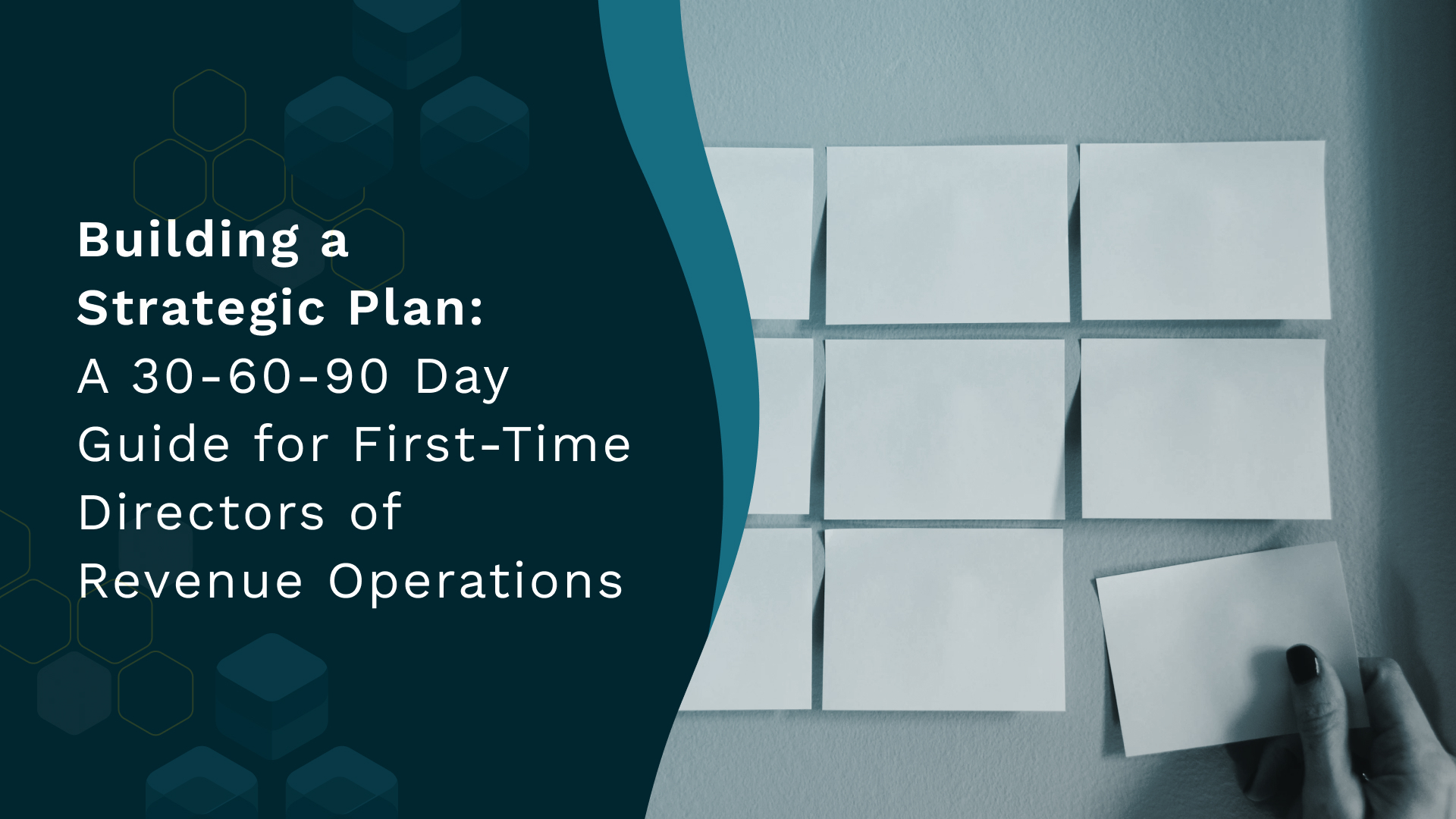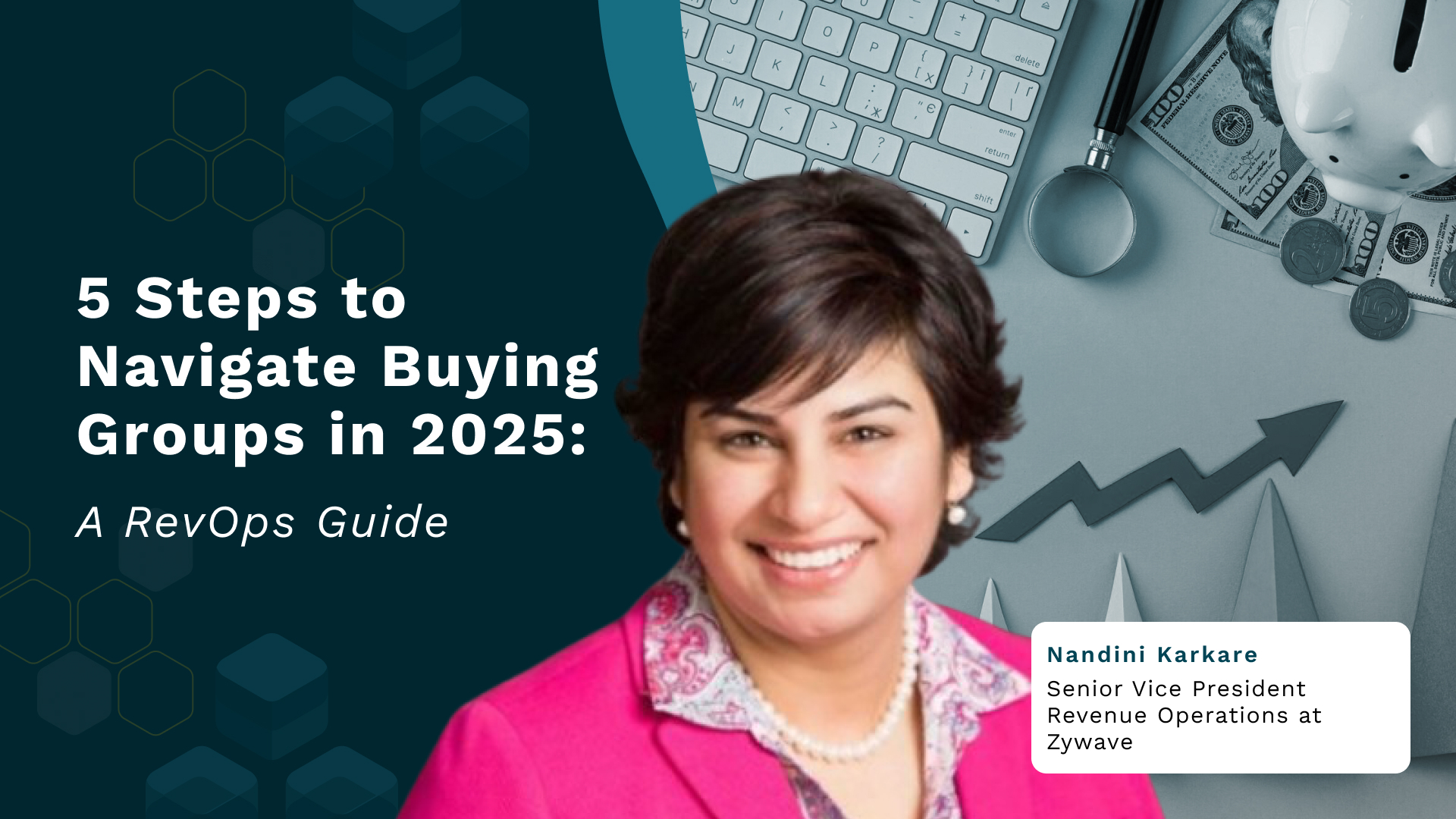Building and Scaling RevOps in the Enterprise
A conversation with Shantanu Mishra, SVP, Revenue Strategy & Operations at Pluralsight.



As organizations scale and mature, the complexity of managing revenue processes across the customer lifecycle intensifies. Revenue Operations (RevOps) is emerging as the linchpin function to harmonize go-to-market strategy, unify cross-functional teams, and enable sustainable growth.
In a recent episode of The Revenue Lounge podcast, Shantanu Mishra, Senior Vice President of Revenue Strategy and Operations at Pluralsight, shared a deeply insightful and structured approach to building a high-performing RevOps organization at the enterprise level. With more than two decades of experience in leading sales operations, customer success, and strategic transformation, Shantanu provides a masterclass in RevOps design, execution, and evolution.
Rethinking RevOps: The Bow-Tie Framework
Traditional funnels end at the point of sale. But in SaaS businesses, revenue generation doesn’t stop once a customer signs the contract. Shantanu introduces the “bow-tie” framework—a more comprehensive visualization of the revenue journey. On the left side of the bow tie is the traditional funnel: lead generation, qualification, and closing. On the right is where the real value emerges: customer onboarding, product adoption, value realization, renewal, and expansion.
“In a SaaS environment, you don’t stop at win. The second stage of the journey starts with onboarding, time-to-value, and finally renewal and expansion. That entire bow-tie has to be managed. That is what revenue operations is.”
The bow-tie model reflects a strategic shift from one-time sales enablement to lifecycle value management. It forces RevOps leaders to look beyond pipeline metrics and build systems that sustain long-term customer value.
Laying the Foundation: Designing for Scale Early
Shantanu emphasizes that regardless of where your company is in its revenue maturity journey—whether you’re at $10M or $100M ARR—you must design for scale. Building RevOps without a long-term vision is like constructing a house without a blueprint. You need to plan for the 20-story skyscraper, even if you’re currently just laying the first floor.
“Like building a house—you need the blueprint upfront. You have to know how big the foundation has to be, whether you’re building one story or twenty.”
This means implementing systems for forecasting, compensation, territory design, and pipeline management that can evolve with the business. As the organization matures, RevOps must move from tactical firefighting to building scalable, repeatable systems with proactive strategy baked in.
Defining the Metrics That Matter
Effective RevOps is data-driven. But metrics can become noise if not structured properly. Shantanu outlines a comprehensive metric framework spanning the entire bow-tie lifecycle:
Forecasting Accuracy: Strive for a forecast that is within +/- 2% accuracy by week 4 of the quarter.
Pipeline Health: Track coverage ratios, opportunity hygiene, commit vs. forecast percentages.
Velocity & Conversion: Measure deal velocity, stage-by-stage conversion rates, AOV, and win rates.
Unit Economics: Key indicators like CAC:LTV, quota-to-OTE ratios, and bookings per rep.
Customer Success Metrics: Monthly active users, license utilization, early renewal engagement.
“If pipeline is clean, forecast is clean. But to scale, you need to ask—are we investing $1 and getting much more than $1 back?”
This systematic approach ensures GTM teams are aligned on how success is measured across the lifecycle, and avoids the trap of siloed performance indicators.
The Org Design Playbook: Horizontal vs Vertical Thinking
RevOps leaders often struggle with structuring their teams. Shantanu proposes an elegant framework: differentiate between horizontal functions that span all GTM units and vertical functions tailored to specific departments.
Horizontal Functions:
Strategy and investment planning
Data and analytics
Enablement
Compensation and deal desk
Metrics and reporting
Vertical Functions:
Sales and success territory design
Forecasting cadence
Department-specific plays (e.g., sales sprints, CS engagements)
“You don’t want sales to have one funnel and marketing to have another. You need a comprehensive view of the bow-tie.”
This design allows centralized control over strategy and insights, while empowering functional leaders to adapt operations to their specific needs.
Finding the Right Talent: Beyond Ops Experts
The complexity of RevOps demands a multidisciplinary team. Shantanu identifies three archetypes every RevOps team needs:
Athletes: Generalists who can adapt and execute across roles.
Builders: Detail-oriented executors who create infrastructure and processes.
Strategists: Big-picture thinkers who drive alignment and long-term planning.
He emphasizes EQ (emotional intelligence), adaptability, and complementary skill sets over pure technical expertise.
“EQ is non-negotiable. The corporate world is faster now—you need stability, not just intelligence.”
RevOps teams also benefit from hires with backgrounds in finance, consulting, IT/business analysis, and enablement.
Data Infrastructure: From Chaos to Clarity
Data can either be an asset or a liability. According to Shantanu, RevOps leaders must partner with data engineering teams early to establish clean, centralized, and accessible datasets.
“Invest in data engineering early. Don’t let RevOps carry the burden of cleaning, merging, and reporting on messy datasets alone.”
He suggests:
Centralizing all GTM data sources (billing, product, usage, marketing automation, CRM, HR, enrichment)
Building a cloud-based warehouse with proper schema design
Defining KPIs before implementing tools or dashboards
This strategy ensures that as tools evolve, the data structure remains robust and analytics-ready.
Operating Rhythms That Drive Accountability
An effective operating model is more than who reports to whom—it’s about cadence, communication, and culture.
Shantanu recommends:
Weekly: Forecasts, pipeline updates, hygiene checks
Monthly: Reports (not meetings) summarizing key metrics
Quarterly: Deep dives into KPIs, unit economics, and strategic planning
He also emphasizes that metrics should be meaningful and contextualized, not just reported. RevOps should take ownership of making reporting useful for decision-making.
Win-Loss Analysis: Real-Time Insights from the Field
Too often, companies wait until end-of-quarter to analyze wins and losses. Shantanu recommends capturing this data continuously and cross-referencing it across sources: deal desk, CRM, sales team debriefs, and direct customer feedback.
“Win-loss data should be captured daily. Don’t wait till the quarter ends to learn why you’re losing.”
Understanding what’s working (or not) in pricing, positioning, or sales process enables faster course corrections and better enablement.
The Future of RevOps: Powered by AI
Shantanu sees artificial intelligence as a transformative force across the revenue engine. Beyond automation, he highlights strategic applications of AI:
Identifying where your ICPs exist across the market
Capturing intent signals to prioritize outreach
Early warning systems for churn and health risk
Competitive intelligence and pattern recognition
“Imagine AI telling you how your competitors are engaging your customers—that’s the future I want to see.”
Rather than waiting for AI to mature, forward-looking RevOps teams must actively explore use cases that align with their strategic priorities.
Final Thoughts: It’s Not Reporting Lines, It’s Relationships
When asked if RevOps should report into the CRO or CFO, Shantanu replied with a powerful truth:
“Org structure matters less than trust, rhythm, and culture. You need honest conversations and mutual accountability. That’s what drives impact.”
Relationships, transparency, and a shared vision are the true enablers of RevOps success.
Want to hear more stories from revenue leaders? Subscribe to The Revenue Lounge podcast to never miss an episode!
More Resources

A 30-60-90 Day Guide for First-Time Directors of Revenue Operations
A 30-60-90 Day Guide for First-Time Directors of Revenue Operations RevOps 10 min Starting a new job as a Director of Revenue Operations is an exciting opportunity to make a significant impact on a company’s revenue growth. To ensure success in this role, it’s essential to have a strategic plan that guides your actions during the crucial first three months. Here’s a 30-60-90 day plan that will help you strategically manage revenue operations and drive sustainable growth. We recently spoke to Hassan Irshad, Director of RevOps at FEVTutor. He shared his approach to this powerful framework, demonstrating how each phase (30, 60, and 90 days) builds strategically upon the last to deliver alignment, trust, and sustained improvement. By breaking down complex goals into achievable milestones, the 30-60-90 day approach empowers RevOps leaders to initiate meaningful change without overwhelming teams. For all the RevOps leaders, it’s a way to approach change with purpose, driving measurable impact and laying the groundwork for long-term success. The 30-60–90 day framework must be an indispensable tool and here is how you can implement progressive, sustainable growth strategies from day one. First 30 days for a Director of Revenue Operations The purpose should be to gather insights and understand the organization, especially the needs and challenges of different teams. 1. Goals for first 30 days: i. Meet Key Stakeholders Meet with cross departmental teams like Finance, HR, and Sales to understand their goals, challenges, and priorities. ii. Document Everything Create a “lay of the land” document summarizing findings on different team goals, challenges, and processes. iii. Understand the Product Take product demos, listen to sales calls, and use tools that show how the product is sold. This helps in understanding the customer needs better. iv. Dive into Your CRM Understand your CRM (whether Salesforce or HubSpot) to assess how the data is organized. This is to check whether it’s easy to use, and identify immediate improvements. The CRM should be the central source of truth, with other tools supporting it. The data should be unified with easier adoption for the teams. v. Build Trust Internally Establish trust within your teams by listening carefully, asking questions about how RevOps can help, and addressing quick fixes to show you’re there to help. Having this trust shows them that you’re here to support their success. Quick wins, such as small fixes that make people’s jobs easier, helps in establishing credibility early. 2. Establish Clear KPIs i. Understanding Team KPIs It is important to ask you stakeholders about the KPIs that matter to understand their goals and what their expectations are. ii. Aligning KPIs Across Teams Different departments oftentimes work in silos. RevOps should strive to align these departments and check if these KPIs match the overall business objectives. Gaps must be closed if their KPIs don’t align. iii. Setting RevOps KPIs As you approach the end of the first 30 days, start establishing RevOps-specific KPIs that match company goals, which may involve metrics like revenue increase, conversion rates, or improvements in overall efficiency. 3. Tech Stack Audit Deep dive into the existing tools that your company is using. Identify all redundancies, and find opportunities to streamline the entire tech stack. i. Map Out Tools Compile a list of all tools used by teams, noting their purpose and how they work with the CRM. ii. Evaluate Use and Cost Determine if tools are actively used or if there are duplicates. Look for cost-saving opportunities by consolidating tools when possible. https://www.youtube.com/watch?v=sVDJ9KI1tGw&t=869s Next 30 days – Alignment and Control The next 30 days marks a shift from discovery to alignment. The goals should be to create cohesion between departments (e.g., Sales, Marketing) and laying down effective controls. The improvements need to be implemented without overwhelming the teams. This phase combines further exploration with actionable improvements with the primary task being bringing the teams into sync. 1. Ways to bring your teams together i. Encouraging cross-team collaboration by addressing silos and ensuring all teams work toward shared quarterly or company-wide goals. ii. By creating alignment, you help teams see RevOps as a support system rather than an enforcer. This keeps communication channels open and creates buy-in. iii. Based on your findings, introduce controls wherever needed to improve workflow. Example: If close dates aren’t being recorded properly, this could skew reports. Meet with sales, identify the root cause (e.g., manual data entry that is taking too much of a reps’ time), and provide solutions or tools to make their tasks easier. Ensure that controls are practical and developed with the trust built in the first 30 days. Foster internal consensus within teams so that these improvements are adopted seamlessly. 2. Navigate Organizational Politics (i) Barrier Removal Larger organizations may have internal politics or ingrained processes that resist change. Find an internal “sponsor” who trusts and supports RevOps initiatives and can authorize actions to navigate any resistance. (ii) Trust and Consistency As you implement changes, make sure your efforts consistently demonstrate how RevOps can make work easier and more efficient for everyone. 3. Evolving the Tech Stack (i) Assessing Tech Needs If tools aren’t fully integrated (e.g., a tool not writing data back to the CRM), identify their gaps and consider evolving the tech stack. (ii) Holistic View Use insights from the discovery and alignment phases to start envisioning necessary tech improvements that align with company goals. Beginning of the 90-Day Phase: Vision and Execution This phase, described as “Vision and Execution,” involves shaping and executing a strategy based on insights gathered from the discovery and alignment phases. a. Roadmap Creation Create a roadmap covering the next two quarters, focusing on long-term, high-impact changes that align with business goals. Use learnings based on stakeholder needs, organizational goals, and the findings from the first 60 days i. Set Priorities Collaborate with end users (Sales, Marketing, Customer Success) to understand their pressing needs and align the roadmap with these needs. ii. Strategic Execution Prioritize initiatives that will have immediate revenue impact or

Top 10 Relationship Intelligence Tools for 2025
Top 10 Relationship Intelligence Tools for 2025 RevOps 10 min When it comes to sales, building strong relationships is essential. But let’s face it, the process can be incredibly time-consuming and demands a significant amount of effort from the sales reps. But here’s the kicker: Today, 44% of millennial buyers prefer minimal contact with a sales rep during the buying process. That means your sales rep has ~5% of the prospect’s time to establish a connection. It’s tougher than ever to develop relationships from a seller’s point of view. Does this mean that your reps should stop building relationships? Should your reps just try and sell whatever they can to whoever you find? The answer to that is a resounding NO. In the digital era, data and insights are what drive sales . They have the potential to give out more information than you know about your prospects. CRMs capture all possible data, churning it and spurting out information that otherwise was not visible earlier. But wait. There’s more to sales success than your CRM. To truly understand your prospects, you need to dig deeper to uncover hidden insights to help close your deals faster. That means mining your CRM data for a wealth of valuable information that will give you a competitive edge. This is exactly what relationship intelligence does. What is a Relationship Intelligence Tool? Picture this: You have access to a wealth of data from your clients, colleagues, and partners, but it’s scattered across various touchpoints like emails, phone calls, messages, meetings, and more. How do you make sense of all that information? That’s where relationship intelligence comes in. By pooling in, processing, and analyzing all that data, relationship intelligence technology provides invaluable insights, builds stronger relationships, and helps you make smarter decisions. With relationship intelligence, you can discover a treasure of data-driven and actionable insights that support the organization’s understanding of the customer, identify the optimal solutions, and determine the best communication strategies. This results in a more tailored and informed approach to prospects to maximize the best chance of a positive outcome. Your prospects are more than just a phone number or an email. Relationship intelligence broadens your potential and plays a strong role in connecting the dots from other sources. It supplements your CRM, finding other & useful opportunities to close prospects, otherwise not visible to us. Why Does a Relationship Intelligence Tool Matter? Enterprise-based selling in B2B is no walk in the park. With a plethora of relationship intelligence tools out in the market, organizations are spoilt for choice. However, tools that leverage AI/ML, offering data-driven intelligence with invaluable and actionable insights, will be the ones that will dominate the market. On the flip side, the process of onboarding a tool no longer rests in the hands of a single decision-maker. Gartner states that the number of buyers involved in the last decade has increased from 5 to 20. A potential account will have multiple stakeholders who will be involved in the decision-making process. Hence, it becomes critical for sales reps to identify and engage with key stakeholders regularly. With the rise of digital selling, organizations can now track the process of selling in a more in-depth manner. All forms of digital outreaches and communication with prospects can now be tracked, analyzed, and acted upon with the help of relationship intelligence. Today, with markets being down and companies being extremely meticulous in their choice of tools to invest, having a relationship intelligence tech stack will be the game-changer. Here’s how 1. Showcasing a single view of all your relationships with your prospects Having relationship intelligence data will bring together all the stakeholders in one view, so sales reps have a clear idea of the sales cycle the account is currently in. 2. Identify every stakeholder involved With the buying process evolving constantly, the final decision often lies not with one but multiple owners. In other words, for a sales rep, multithreading is the best way forward. And in this process, it’s very easy to confuse the right person to engage with, especially if there is a handover involved. Sales reps often fail to map out the stakeholders involved. The dots are not connected and not visible, which can lead to confusion and no clarity to other higher authorities. Relationship intelligence tools fill these gaps. It will identify each & every stakeholder involved at every stage of the selling process, bring them together, and map out the relationship of each, and provide all the information about these stakeholders. Not only that, but the data also provide insights to those who are frequently engaging and also point out the next best champion to continue the sales process seamlessly if the key decision maker is unavailable at any stage of the sales process. 3. Give detailed insights about each prospect The thing about relationship intelligence tools is that not only do they provide details in one place, but they also show you the best possible way to contact and reach out to your prospects. It can be email, phone calls, or video calls; it will give you solutions that are sure to boost your process of converting. 4. Recover lost leads In the world of sales, not all leads or prospects will convert. If the target is to convert 2 leads in a month with a value of X, sales reps need to build a pipeline of at least 10 leads with a value of 10X. This results in 8 leads that will not convert or be disqualified or lost in the process. However, these 8 leads don’t have to be lost forever. With relationship intelligence, you can identify the most engaged buyers and reignite the relationship with them. And here’s the kicker: the relationship intelligence technology considers all the data even before onboarding the tool. This kind of intelligence will only unleash hidden superpowers for your sales reps. Who knows, your lost prospect’s business priorities might have changed over time, and getting back to them might just make all the difference. 4. Discover trends in

5 Steps to Navigate Buying Groups in 2025: A RevOps Guide
5 Steps to Navigate Buying Groups in 2025: A RevOps Guide RevOps 10 min In today’s business environment, B2B buying is never just one person. According to Forrester Research, more than half of global business buyers purchase in complex buying scenarios that include more people, more departments, and generally higher price points. And this buying group can be made up of 7 to 20 people! Unlocking the power of buying groups is a crucial aspect of the B2B landscape. This blog is a synopsis of our conversation with revenue operations leader, Nandini Karkare. She is currently the SVP of RevOps at Zywave. Nandini suggests strategic steps to navigate through the realms of Revenue Operations and helps uncover the strategies, insights, and best practices that constitute a comprehensive guide to mastering the dynamics of buying groups. Read on to get actionable tips on how you can navigate buying groups in 2025 (and beyond). And implement the learnings to create a winning GTM motion. Here are the 5 steps Nandini recommends: 1. Decode Your Buying Groups The buying groups typically consist of members from departments and they all contribute different aspects. It is critical to understand the scope of decision-making including the people who play the most significant roles in making the call. Gartner’s report on B2B Buying highlights that 77% of B2B purchases involve a buying group of four or more people. PS: The key stakeholder can turn out someone altogether different from who you had building a relationship with all along. a. Capturing Buying Group Members Effective buying group management means considering not just decision-makers but influential stakeholders across departments. Misidentifying key players or focusing solely on the main contact risks derailing the sale. (i) How can you map the entire buying group efficiently? Leverage internal and external data to identify the key players Segment the Group by Role and Influence (ii) Not everyone in the buying group holds equal power or influence. Segment them into categories: Decision-makers (who give the final heads-up) Influencers (who sway the decision) Users (who use the product and provide feedback) Budget owners b. The Role Transition Within a Buying Group Moving the focus from a buying group to a renewal or expansion committee includes knowing precisely who remains in the relationship, as well as who becomes more active as an account grows. (i) New roles may emerge in a Buying Group Technical or operational leaders may become more influential post sale, since they are now using the product. (ii) The focus shifts from buying to renewal The interaction should be more about the return on investment (ROI) of the product placed on the market, ongoing value delivery, and ongoing needs. (iii) Alignment between the buying groups and renewal committee Leveraging the same enthusiasm and relationships generated at the first-buying stage helps in anchoring the transitions and preventing any drop-offs in engagement. Related Resource: Navigate Enterprise Buying Committees: Strategies for Driving Alignment c. Understand the Personal and Collective Priorities of a Buying Group As per McKinsey & Company, B2B buying decisions increasingly require engagement across departments, with 60% of purchasing committees including members from outside traditional procurement, like IT and HR. (i)Alignment Between C-Suite and Technical Teams Decisions aren’t Made in a Vacuum Collaboration between C-suite and technical teams ensures a holistic approach to solving customer problems, creating stronger, more sustainable relationships Their cross departmental collaboration can help with: (ii) Alignment on Strategic Goals C suite executives need technical assistance to translate their strategic vision to reality that also aligns with company-wide objectives. (iii) Technical Validation These insights guide the C-suite in making informed decisions that fit technical infrastructure and future-proofing. (iv) Cross-functional Communication Bridging the gap between these two groups involves continuous, open communication, ensuring that technical evaluations don’t delay business goals but instead support them cohesively. iii. Understand the Product Take product demos, listen to sales calls, and use tools that show how the product is sold. This helps in understanding the customer needs better. iv. Dive into Your CRM Understand your CRM (whether Salesforce or HubSpot) to assess how the data is organized. This is to check whether it’s easy to use, and identify immediate improvements. The CRM should be the central source of truth, with other tools supporting it. The data should be unified with easier adoption for the teams. v. Build Trust Internally Establish trust within your teams by listening carefully, asking questions about how RevOps can help, and addressing quick fixes to show you’re there to help. Having this trust shows them that you’re here to support their success. Quick wins, such as small fixes that make people’s jobs easier, helps in establishing credibility early. 2. Establish Clear KPIs i. Understanding Team KPIs It is important to ask you stakeholders about the KPIs that matter to understand their goals and what their expectations are. ii. Aligning KPIs Across Teams Different departments oftentimes work in silos. RevOps should strive to align these departments and check if these KPIs match the overall business objectives. Gaps must be closed if their KPIs don’t align. iii. Setting RevOps KPIs As you approach the end of the first 30 days, start establishing RevOps-specific KPIs that match company goals, which may involve metrics like revenue increase, conversion rates, or improvements in overall efficiency. 3. Tech Stack Audit Deep dive into the existing tools that your company is using. Identify all redundancies, and find opportunities to streamline the entire tech stack. i. Map Out Tools Compile a list of all tools used by teams, noting their purpose and how they work with the CRM. ii. Evaluate Use and Cost Determine if tools are actively used or if there are duplicates. Look for cost-saving opportunities by consolidating tools when possible. https://www.youtube.com/watch?v=sVDJ9KI1tGw&t=869s Next 30 days – Alignment and Control The next 30 days marks a shift from discovery to alignment. The goals should be to create cohesion between departments (e.g., Sales, Marketing) and laying down effective controls. The improvements need to be implemented without overwhelming the teams. This phase combines